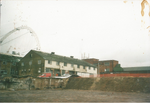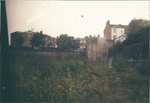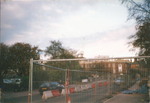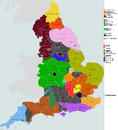Stats[]
The Provisional Republic of the UK (PRUK) is a democratic UK survivor nation based in the English Midlands and-mid Wales. It uses 'UK' in it's name in reference to the pre-war United Kingdom (UK). President Geoff Hoon regards him self as regent until a remaining British royal is found and installed as monarch.
History[]
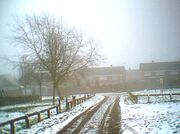
Nuclear winter in Heanor, Amber Valley, in 1962.

Ashbourne in April, 1964.
Also see- The Provisional Republic of the UK.
1962: The Apocalypse[]
On "The Apocalypse of 1962", the the region was in a precarious position, caught between the major nuclear targets of Birmingham and Manchester, and also near the nuclear targets of Greenham Common AFB, Sheffield, Nottingham, and the NATO airbases in Nottinghamshire and Lincolnshire.
Nottinghamshire’s RAF Langar and RAF Syerston were toast under 2 separate 1kt missiles. A 10kt device had destroyed Nottingham. Sinfin was a southern suburb of Derby and historically speaking, it was a separate village. It once contained the main centre of Rolls-Royce, on Nightingale Road, as well as the housing developments of new Sinfin and Stenson Fields, which was hit by a 1kt missile and Derby was missed by a 10Kt one (it reportedly detonated in the rural Derbyshire Borough of High Peak, near the Staffordshire border). Ratcliffe-on-Soar Power Station, Long Eaton, RAF Hucknall and the East Midlands Airport were targeted, but the 1kt ICBMs failed to go off and only broke up on impact, spewing radiation over them, dirty bomb style. Oddly, the Ironbridge power stations grouping was never even targeted by the USSR in the first place.

The remnants of RAF Longsparrow as seen by the Irish media in 2010.
The West Midlands counterurbanisation was destroyed by heavy and multiple nuclear assaults. It was hit multiple warheads with 10kt, 100kt and 200kt yeld's on Birmingham, Coventry, Old Hill, Cradley Heath and Wolverhampton. A 10kt strike also occered at Smethwick. Stoke-on-Trent got a 50kt ICBM. Kineton army depot was hit by 2 1kt missiles, while, RAF Madley, Coventry Airport and West Midlands Airport were all destroyed with a further 3 1kt devices.
Strangely, nether RAF Throckmorton or RAF Codsall or the Ironbridge power stations grouping were even targeted by the USSR in the first place. The 2 10kt missiles meant to hit Stafford also fell short and hit the ruins of Wolverhampton instead. A 1kt device had exploded in the north of the city of Crewe, whilst another 1kt device had missed Upper Heyford and hit Banbury instead.
Other missile strikes were at-
Also see- WP Targets in the UK and Ireland.
Survival[]
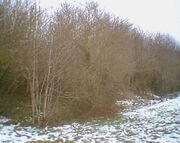
Temperatures fell six degrees below average in the nuclear winter of 1962-63. The field is near Hook Norton. Radiation has ruined the film.

a motorway near Warwick in mid 1962.
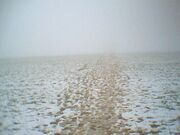
The nuclear winter on Cannock Chase, in late 1962.

Temperatures rose to five degrees above average in the nuclear summer of 1963.
Also see- Some ad hock weather data for Hereford Holy Cross CoE secondary school
Following Doomsday, all the counties that would form The Provisional Republic of the UK cared about was survival. Most towns kept to themselves, desperately cultivating the land and trying to care for the sick and wounded while the remaining councillors and police chiefs of the old shire governments forming loose confederacies over each county in an attempt to restore order to the regions as thousand fled towards the Staffordshire Moorlands, Clun Valley, Shropshire Hills and Malvern Hills.
2 of the 4 West Midlands’ RSGs were destroyed- The Drakelow Tunnels, near Kidderminster had caved-in and the offices in Shirley, Birmingham, were levelled. The serving 2 were at Shrewsbury Police HQ and the United Kingdom Warning and Monitoring Organisation bunker at Lawford Heath near Rugby. Neither could communicate due to the EMP hitting communications, power outages and a wrecked transport system; but they at least managed to hold sway over the greater part of each of their counties in the early months.
As the public fled to rural regions such as the Staffordshire moorland and the Derbyshire dales, chaos and anarchy loomed. Radiation sickest, septic wounds and starvation would take their toll to. With radiation levels as they were, Derby was evacuated and quarantine for several years, while drinking from the River Trent and River Derwent was banned for the foreseeable future by the various local militias, community committees and criminal gangs that ran the former Ashbourne-Derby-Nottingham-Hazelwood zone. The relatively unscathed towns of Burton-upon-Trent, Melton Mowbray and Loughborough did what it could to help, but were also suffering from radiation sickness and a crime wave.
Melton Mowbray RDC and Loughborough UDC (who were not directly hit) managed to organise and maintain a refugee community, but radiation would be a major killer in the early years. Loughborough slowly expanded over the years, to include minor towns of Shepshed, Castle Downington and Coalville by 1985.
Others gathered around the towns of Hook and Chipping Norton. The effects of radiation sickness, exsposure, septic wounds and starvation would take their toll to. With radiation levels as they were, Abingdon, Banbury, Oxford and Bicester were evacuated and quarantine for several years, while drinking from the River Cherwell was banned for the foreseeable future by the various local militias, community committees and criminal gangs that ran the former Banbury-Chalcombe zone. The relatively unscathed town of Hook Norton did what it could to help, but were also suffering from radiation sickness and a crime wave.
Serviving places like Chipping Norton, Right Roleright, Over Norton, South Newington, Wroxton, Chadligton, Enstone, Wiggington, Mollington, Epwell, Hornton, Hanwell, Hook Norton and Brackley were soon flooded with refugees.
As the majority of the region’s survivors fled in to mid Wales, chaos and major shortages also hit Breconshire, Radnorshire, Montgomeryshire and Shropshire by early 1963.
A severe famine and a cholera outbreak hit the region, killing many people during 1963 and most of 1964.
1964-66[]
Though each county in the West Midlands region and eastern Wales was nominally independent they knew about the others around it by late 1964, but there was little interaction other than in handling the refugee flows from what remained of the West Midland’s county through their government’s territories. Each government was:
- Interim State of Staffordshire
- Provisional Republic of Shropshire
- Worcestershire Confederacy
- Warwickshire County Union
- Herefordshire Provisional Government
- The Committee for Oswestry Borough.
- The Committee for Strafford-upon Avon- Borough.
- The Llangollen- Chirk union.
- The community of Montgomeryshire.
- Wrexham City Union.
A severe famine and an urban cholera outbreak hit the region, killing many people during 1965 and most of 1966. This was further compounded, when several cases of chronic equine infectious anemia were also reported to vets in mid to late 1966. It was noted Staffordshire had suffered the most, while Herefordshire come out the least effected of all.
As the situation stabilised,the surviving members of Ashborne RDC, Repton RDC, Belper RDC and Ashborne UDC councils met in Ashbourne, Derbyshire, to form a new provisional government (along with their allies clegues from Burton-upon-Trent MDC, Bingham (Notts) RDC and Melton Mowbray RDC) on May 6th, 1966. Hack Green RSG bunker granularly drifted under the control of Shropshire and Staffordshire after 1966 and joined Staffordshire in 1972.
The leaders of several town councils in Derbyshire decided to band together and form a temporary governmentin 1967 until official word from the British government had arrived. Over the next few years after doomsday, these town councils were also joined by others in Nottinghamshire, Leicestershire and Staffordshire. After the anniversary of the attacks, the councillors decided upon throwing a public vote to decide whether they should establish their own independent nation. The population voted in favour of the creation of the New Derbyshire Republic. On December 18th, 1966, the constitution of the New Derbyshire Republic was signed, and the new state was founded.
The capital of Derbyshire would be moved from Repton to Derby’s Chaddesden estate (which had a small survivor community of about 100 people in it), after the radiation levels had fallen to safer levels in 1978. Derby will remain the permanent capital, unless a catastrophe strikes the nation. Both small survivor communities and savage feral dogs have been found in the Littleover, Normanton and Mickleover districts of Derby by 1985 survey team.
The surviving members of Oxfordshire county council, Hook Norton urban district council and Ploughley rural district Council met in Hook Norton, to form a new provisional government December 18th, 1966.
As off that date, the people of Chipping Norton, Right Roleright, Over Norton, Shutford, Wroxton, Chadligton, Enstone, Wiggington, Hornton, Hanwell and Chastleton united as one in order to save what little they could and to survive the in the much dreaded future that awaited them!
1967-1974[]
Melton Mowbray and Bingham felt neglected by the New Derbyshire Republic, which was inevitably rather Derbyshire-Staffordshire centric at the time. It was claimed that food and fuel rationing was bias against Melton Mowbray and Bingham. The separation of 1967 was peaceable and the separatists set about getting rid of any perceived bias in the food chain. They also started clearing some Nottinghamshire woodland to create fire wood, timber and farmland of their own.
The nations' agriculture and thus food supplies have been slowly recovering in all it's costiuent natons since 1970, but this would become much more noticeable after 1974.
As time passed things improved and agriculture had started to pick up in the region by 1970. Once food ration became obsolescent the two nations became friends once more and the Melton Mowbray and Bingham Republic re-joined the New Derbyshire Republic in 1976.
First Contact[]

Worcester in 2011.

Much war-damage remained in the city of Stafford as of 1998.
Explorers from Northamptonshire and Market Harborough arrived in Melton Mowbray in 1968 and Kibworth trader made first nation's contact with Melton Mowbray and Bingham Republic in 1969.
Traders from Buckinghamshire first discovered Mercia in 1974 and the nations started formal relations a year later. In 1975, the republics made first contact with another survivor nations, Scarboroughshire after a joint team of Mercian and New Derbyshire explorers went far east of the remains of Grimsbury port and encountered a team of earmy scouts from Scarboughshire. The Republic of the New Derbyshire Republic was able to establish diplomatic relations with other British survivor nations, such as the Republic of East Anglia, The Republic of Hexham, The Duchy of Lancashire, and the Kingdom of Wessex, and also with the Ireland. A single carriage steam train from Matlock in North Derbyshire arrived in Belper in 1976. A small village was found near Ambergates' former location in 1977, which was soon assimilated.
First contact was made between the Mercians and the South English Republic in early 1976, in a series of border clashes in and around Rugby and Long Buckby. The growing city states of Gloucester and Stroud, Liecsester and the Winchester were also discovered by chance in 1976.
As the South Welsh moved farther north in to Radnorshire and east through the forest of Dean, they clashed with the locals, but Mercia was willing to give some settlement rights in the western Herefordshire, Clun Valley, the Shropshire Hills and Wye Valley after the Mercians (one of the founders of the Provisional Republic of the UK) realized that they had a heavy manpower shortage in 1974. This treaty would be abandoned in 1976 after a Welsh attempt to annex the regions in to Breconshire.
Loughborough’s first contact was made with the South English Republic’s in mid-1976. Mercia’s There was also series of raids in the aria around Banbury’s ruins in 1989. The Southern English goal appeared to be the old Ironsone mine, near Wroxton, Oxfordshire.
Brackley was discovered by Mercia in 1986, but it remained isolationist in nature.
Irish explorers, who were documenting the geography of post-Doomsday Britain in 1976, found that the settlements they were coming across were not simply communities of survivors scratching at the ground to get food. There were organised housing and there appeared to be some form of social security. Amongst the West Midlands region’s municipalities, the stories of the Irish and Scottish outlanders spread until they reached the regional authority in Stafford. The Mercian government met with the Irish and Scottish Highlanders, and a few months later made diplomatic contact with the Irish government itself. Aid poured in and over time, Mercia came to realise the true magnitude of the network of nation that criss-crossed the British Isles.
Conflict with South Wales[]
When Republic of South Wales attempted to predate high grade Mercian agricultural land off of Herefordshire and Shropshire in the 1976, there was much worry and anger in Mercia, who had long feared this. This lead to the 1977 battle of Clun, in which Clun Bridge was destroyed. Mercian held Ross-on-Wye also saw an anti-Welsh riot in late 1978. Machynlleth and Llanidloes chose to join Mercia out of fear of the Welsh S.S.R. in 1979.
After the Mercians had defeated the Welsh provisional army and ejected the settlers from the Clun Valley and Shropshire Hills South Wales was on the retreat. Things became more chaotic as the Mercia, West Wiltshire and Wessex successfully laid siege to Monmouth for a month, while simultaneously overrunning Hey-on-Wye and New Radnor in 1979. The reformist communist/socialist element of the regime then entered a civil war with the hard-line communists, nationalists and pro-democracy movement between 1979 and 1984 in which the towns of Brecon, Carthenshire, Cwmbrân and Abercynon would suffered greatly.
The political stirrings of the 1970’s and founding of the new republics.[]

The former West Midlands region.
However, the death rates increased by 1976, especially in Staffordshire and Warwickshire as radioactive fallout had travelled north east. In these counties especially, the government tightened control, much to the consternation of the people, who disliked having to produce a quota of food each month and tribute it to the increasingly authoritarian Provisional General Government. Collective granaries were set up as people were made to contribute for all. All land was converted into arable land if it was possible.
Daw Mill coal mine was reopened in 1980 and run on a mixture of native conscript labour and slaves captured from the variouse resounding tribes and city states. These policies though sensible were unpopular with most people having gotten used to little governmental interference and looking after themselves. Life required much more work because of the food and coal quotas. A left wing secret police and secret police was formed from variouse have a go heros, a few dozen corrupt policed men, desperate solders, trades union’s heavies and local gang members.
Loughborough wished to remain an independent and friendly city state, but eventually joined in 1976, after falling victim to a series of raids by the paramilitary forces of the South English Republic that year around the disputed and now mostly ruined towns of Ashby-de-la-Zouch, Hinckley, Market Bosworth and Moira in Leicestershire. The South English Republic’s goal appeared to be the old Rawdon Colliery, near Moira, in 1979 raid.
In the other counties, the tightening up of central power was still there but much slower and less interventionist than in Staffordshire and Warwickshire. There was increasing feeling within these counties that the old UK was dead and buried and they didn't even know how the rest of the country was doing beyond a few neighbouring towns like Burton-upon-Trent. For this reason, Shropshire, Oswestry and Herefordshire dropped their provisional status in 1981, with the rest following in 1982 and 1983. By that time, it was like this.
- State of Stafford (May 1st, 1981)
- Salopian Republic (June 5th, 1983)
- Federation of Worcestershire (June 5th, 1983)
- Warwickshire Social Republic (May 2n, 1981)
- Nation of Herefordshire (October 3rd, 1982)
- The Free Town of Oswestry (May 3rd, 1981)
- The Republic of Strafford- upon- Avon (May 1st, 1982)
- The Llangollen- Chirk federation (October 3rd, 1982)
- The Republican city-state of Wrexham (October 3rd, 1982)
- The independent community of Montgomeryshire (June 5th, 1983)
The 1984 Mercian Revolution[]
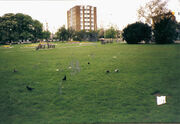
A estate in the south of Repton in 2008.
In 1984, however the people of Warwickshire, Strafford- upon- Avon and Staffordshire rose up and economies had come to rely on ineffective interventionist policies and anarchy became widespread. Soon, the Union of Llangollen- Chirk, The community of Montgomeryshire and The Republican city-state of Wrexham began to formulate its own city militia to see off Welsh raiders from the former county of Powys. The four other nations looked on in horror as they watched their cousins tear themselves apart in a left wing-right wing-Liberalist orientated civil war.
A severe famine and a cholera outbreak then hit the region, killing many people during 1985 and most of 1986. The Porcine reproductive and respiratory syndrome virus (PRRSV), also known among farmers as 'blue-ear pig disease' also killed some pigs in late 1986.
The Welsh SSR also attempted to predate high grade agricultural and land off of Herefordshire and Shropshire in the middle of that year. This lead to the 1987 battle of Clun, in which Clun Bridge was destroyed. Ross-on-Wye also saw an anti-Welsh riot in late 1988.
To prevent any more domestic bloodshed and to reduce the threat posed by both the Southern England and The Welsh SSR, The Independent Mercian Community was founded in 1986 and stepped in to restore order, establishing Warwickshire and Staffordshire as Territories of the Community in 1998 until they could be readmitted as States. The Community became a very loose confederacy and more and more the idea of being Mercian appealed more and more, mostly because it was hard to identify oneself as being a Worcesterian or a Hereforder and easier to identify as being Mercian.
Federalisation[]
In 1989 on the same day that Warwickshire and Staffordshire became States, the Mercian Community became the Mercian Federal Republic. They adopted a Constitution similar to the United States and established a presidency, making it one of the few truly republican nations to be home-grown in the Isle of Great Britain. The rallying cry went out to Derbyshire, the Brackley and Hinton-in-the Hedges-Union, the Welsh SSR and the minor city states of Oxfordshire, north Gloucestershire and south Cheshire.
The Provisional Republic of the UK[]
Döner kebabs or döner kebaps have become rather popular since there introduction by Izmirie immigrants in 1999.
Defence and transport was already jointly run with by the nations of the union since 1989. Most shanty towns were given sanitation and clean water by 1996, and were them mostly replaced by proper housing between 1997 and 1998. Adult educational policy became a priority after 1999. The various nations came to gathers in 1999 and formed the federal nation of ‘The Provisional Republic of the UK’. A small bio-mass power station was built in south of Worcester in 2001. The unassimilated (and sometimes pro-Irish) villagers of northern Cardiganshire also chose to join in 2003 after getting technical and farming help from the PRUK. Brackley joined the union in 2006, after the death of its isolationist and right wing warlord due to dysentery. Loughborough and Leicester had started integrating in 1996, but only fully entered the PRUK in 2006.
The 2007 treaty of Rhyl[]
In the 2007 treaty of Rhyl, the Welsh SSR/PRUK/Pembrokeshire borders were re-drawn as follows-
- Monmouth BC, Monmouth RDC, Chepstow RDC, Chepstow MDC, Aberystwyth UDC, Aberystwyth RDC, and Tregarnon RDC Hey-on-Wye town and Radnorshire joined the PRUK.
- Lampiter BC, Aberaeron UDC and Aberaeron RDC join Pembrokeshire.
- The rest of Monmouthshire joins the Welsh SSR.
- The New Quay MDC joined Ireland.
New Quay joined Ireland after a 75% yes vote in a 1999 referendum on the issue, held under UN supervision.
Windward Electrical Project[]
The Windward Electrical Project system was founded by Rutland, the PRUK and Central Northamptonshire and Buckinghamshire in 1998. Other nations joined the project in 1999 and 2004. Connection was between 2005 and 2009, depending on location.
Natural disasters[]
Earthquake[]
An earthquake rocked the ruins of Dudley town and a large surrounding aria, reaching out as far as Hereford, in the early morning of 22 September 2002 (as in OTL) . It registering 4.7 on the Richter scale according to scientists in the Kingdom of Lille-Wallonia and the PRUK, and lasted approximately 20 seconds. An aftershock of magnitude 2.7 occurred on 23 September at the same time, but was not felt beyond Reddich.
Bad weather[]
There was major flooding between June and August 2007, in which 7 people died. The winter of 2009-2010 was the worst in 50 years, in which 8 fatalities occurred.
A gale and giant hail, which was the size of golf balls, devastated Kibworth, Loughborough and Melton Mowbray and Kettering, killing 2 people in Loughborough and a horse in Kibworth in the June of 2012. The floods and hurricanes of June and July 2012 Killed 2 Walloon tourists in Cardiff, a middel aged man in Shropshire, a pensioner was killed in Long Eaton and a 7 year old girl in Staffordshire.
The honorific floods and cyclone of November 22-28, 2012, devastated the former UK and Ireland. It finally killed a total of 42 people (39 citizens and 3 tourists)- 4 in Newlyn, 1 in Honiton, 1 in Truro, 3 in Exeter, 1 in Bovney Tracy, 2 in Shrewsbury, 2 in Gloucester, 2 in St Asaph, 1 in Wexford, 1 in Preston, 1 in Penrith 1 in Ayr, 1 in Cambridge, 3 in Monmouth, 2 in Northallerton, 2 in Kempsey, 1 in Chester, 1 Warwick, 1 in Derby, 1 Bridgewater, 3 in Upton-upon-Severn and 4 in Malmesbury, plus 3 Lower Saxon tourists in Warwick. It was the worst flooding incident in nearly 100 years! Aid came from Hexanshire, Durhamshire, Scarborough, Ayrshire, Perthshire, Denmark, Sussex, Willihamshaven, Kingdom of Lille-Wallonia, and the Neo-Roman Empire.
Former refugee camps[]
Refugee camps were built in several places between 1962 and 1972, including-
- Hook Norton
- Chipping Norton
- Alton Towers
- Ashbourne (in Derbyshire),
- Melton Mowbray
- Clun Valley,
- Much Wenlock
- Great Malvern
- Chepstow
- Brackley
- New Radnor.
- Lampiter
- It was reckoned, as of 2004, by the Europa Alliance, that about 36,400,000 died across the UK out of a population of 53,292,000, as a result of the Soviet attack. The 16,796,000 survivors were mostly in rural places. 1,500,000 later died off due to their wounds, growing ill health, and in the environmental chaos that followed afterwards.










